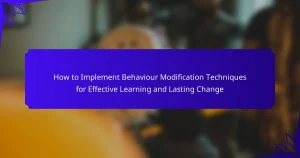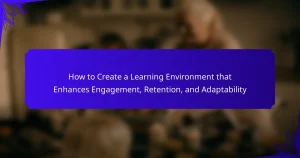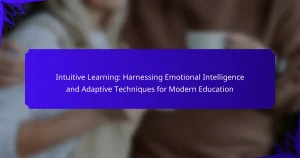Enhancing cognitive skills is essential for effective learning outcomes. Conditioning techniques, such as classical and operant conditioning, shape behaviours and improve retention. Modern approaches integrate technology, like gamification, to increase engagement and motivation. Additionally, personalised learning experiences cater to individual needs, fostering adaptability and critical thinking.

What is Conditioning and How Does it Influence Learning Outcomes?
Conditioning significantly influences learning outcomes by shaping behaviours and cognitive skills. Through techniques like classical and operant conditioning, individuals can enhance their ability to learn and adapt. Research shows that consistent reinforcement improves retention and application of knowledge. For instance, integrating technology in conditioning practices, such as gamification, has been shown to increase engagement and motivation, leading to better learning outcomes. These modern techniques leverage the psychological principles of conditioning to create effective educational environments.
What are the key principles of conditioning in educational contexts?
Conditioning in educational contexts relies on reinforcement and behaviour modification to enhance learning outcomes. Key principles include positive reinforcement, which encourages desired behaviours through rewards; negative reinforcement, which removes undesirable stimuli to promote learning; and the use of systematic desensitisation to reduce anxiety in learners. These techniques leverage cognitive skills by creating structured environments that foster engagement and retention.
How does operant conditioning enhance cognitive skills?
Operant conditioning enhances cognitive skills by reinforcing desired behaviours through rewards and consequences. This technique fosters critical thinking and problem-solving abilities by encouraging active engagement and adaptation to challenges. Research shows that consistent reinforcement can lead to improved memory retention and learning efficiency. Additionally, operant conditioning can be tailored to individual learning styles, making it a unique approach in educational settings.
What are the practical applications of reinforcement strategies?
Reinforcement strategies have practical applications in education, behaviour modification, and skill development. In educational settings, they enhance student engagement and motivation through positive feedback and rewards. Behaviour modification programmes utilise reinforcement to encourage desired actions while reducing undesirable behaviours. In skill development, techniques such as gamification apply reinforcement to promote continuous learning and mastery. Each application leverages unique attributes of reinforcement to achieve specific learning outcomes.
How can punishment impact learning outcomes?
Punishment can negatively impact learning outcomes by creating anxiety and reducing motivation. Research indicates that punitive measures may hinder cognitive skills development and discourage engagement. Effective learning environments prioritise positive reinforcement, fostering a growth mindset. This approach enhances retention and encourages exploration, ultimately leading to better educational results.
What role does classical conditioning play in learning?
Classical conditioning significantly enhances learning by creating associations between stimuli and responses. This process allows individuals to develop cognitive skills through repeated experiences. For example, a student may learn to associate a specific sound with the start of a lesson, leading to improved focus and readiness. This technique can be applied in educational settings, utilising modern technology to reinforce learning outcomes. By integrating classical conditioning with innovative methods, educators can effectively enhance students’ engagement and retention of information.
How can associations be formed to improve memory retention?
Associations can be formed to improve memory retention by linking new information with existing knowledge. Techniques such as mnemonic devices, visualisation, and storytelling enhance cognitive connections. These methods create unique attributes that strengthen recall by engaging multiple senses, making the information more memorable. For example, using vivid imagery or relatable narratives helps solidify the learning experience. As a result, the brain forms a robust semantic network, facilitating easier retrieval of information.

What are the Universal Benefits of Modern Conditioning Techniques?
Modern conditioning techniques enhance cognitive skills by improving learning efficiency, adaptability, and retention. These methods utilise technology to provide personalised learning experiences, fostering engagement and motivation.
Key benefits include increased focus, better memory recall, and the ability to apply learned concepts in real-life scenarios. Research shows that incorporating gamified elements can lead to a 20% increase in retention rates.
Additionally, these techniques promote critical thinking and problem-solving skills, essential for navigating complex tasks. As a result, learners become more proficient and confident in their abilities.
Overall, modern conditioning techniques provide a comprehensive approach to enhancing cognitive skills, making learning more effective and enjoyable.
How do modern techniques improve engagement in learning?
Modern techniques significantly enhance engagement in learning by utilising interactive tools, personalised content, and data-driven insights. These methods foster active participation, making learning experiences more immersive and effective. For instance, gamification incorporates game elements to motivate learners, while adaptive learning platforms tailor content to individual needs, improving retention rates. Furthermore, analytics provide educators with valuable feedback, enabling continuous improvement in teaching strategies. Overall, these advancements create a dynamic learning environment that promotes cognitive skill development.
What cognitive skills are enhanced through these methods?
Conditioning and modern techniques enhance cognitive skills such as memory, attention, problem-solving, and critical thinking. These methods promote neuroplasticity, allowing the brain to adapt and improve its functions. For example, gamified learning increases engagement, leading to better retention of information. Additionally, personalised feedback mechanisms provide tailored learning experiences, further enhancing cognitive development.
How can technology facilitate better conditioning outcomes?
Technology can significantly enhance conditioning outcomes by providing tailored learning experiences. Adaptive learning platforms utilise data analytics to customise training programmes, ensuring optimal engagement and retention. Interactive tools such as gamification increase motivation, making learning more enjoyable. Virtual reality simulations offer immersive environments for practical application, enhancing cognitive skill development. Additionally, wearable devices track progress and provide real-time feedback, fostering continuous improvement. These innovations collectively create a more effective and personalised conditioning framework, ultimately leading to better learning outcomes.

What Unique Attributes Distinguish Modern Conditioning Approaches?
Modern conditioning approaches are distinguished by their emphasis on technology integration, personalised learning experiences, and data-driven methodologies. These unique attributes enhance cognitive skills effectively. Technology tools, such as apps and virtual reality, facilitate immersive learning environments. Personalised techniques adapt to individual learning styles, promoting engagement and retention. Data analytics provide insights into progress, allowing for tailored interventions. Together, these attributes create a more dynamic and responsive learning framework.
How do gamification and interactive learning reshape conditioning?
Gamification and interactive learning significantly enhance conditioning by increasing engagement and motivation. These techniques promote active participation, leading to improved cognitive skills and retention of information. Gamification introduces elements like rewards and challenges, which stimulate learners and create a competitive environment. Interactive learning fosters real-time feedback, allowing learners to adapt their strategies effectively. Research shows that these methods can boost learning outcomes by up to 30%, demonstrating their effectiveness in reshaping traditional conditioning approaches.
What innovative technologies are being utilised in conditioning?
Innovative technologies in conditioning include virtual reality, artificial intelligence, and gamification. These tools enhance engagement and personalise learning experiences, leading to improved cognitive skills. Virtual reality immerses learners in realistic scenarios, while artificial intelligence adapts content to individual needs. Gamification introduces game-like elements to motivate and sustain interest in the learning process.
How does virtual reality impact learning experiences?
Virtual reality significantly enhances learning experiences by immersing learners in interactive environments. This technology improves cognitive skills through experiential learning, allowing users to practice and apply knowledge in realistic scenarios. Research indicates that VR can increase retention rates by up to 75%, making it a powerful tool for education. Additionally, VR accommodates diverse learning styles, providing tailored experiences that meet individual needs. As a result, learners can engage more deeply, leading to improved outcomes and skill acquisition.
What is the significance of personalised learning algorithms?
Personalised learning algorithms significantly enhance cognitive skills by tailoring educational experiences to individual needs. These algorithms analyse learner data, adapting content delivery and pacing to optimise engagement and retention. As a result, students achieve better learning outcomes and develop critical thinking skills more effectively. Personalised approaches foster motivation and self-directed learning, making them essential in modern educational technology.

What Rare Attributes Can Enhance Conditioning Outcomes?
Incorporating rare attributes can significantly enhance conditioning outcomes. Techniques such as neurofeedback, which optimises brain function, and gamification, which increases engagement, are effective. These methods leverage unique aspects like real-time data analysis and interactive learning environments to boost cognitive skills.
How can neurofeedback be integrated into learning processes?
Neurofeedback can be integrated into learning processes by enhancing attention and emotional regulation. This technique trains learners to optimise brain function, leading to improved cognitive skills. Research shows that neurofeedback can increase focus and reduce anxiety, which are essential for effective learning. Additionally, it provides real-time feedback, allowing students to adjust their mental states for better retention and understanding. Implementing neurofeedback in educational settings can foster a more conducive learning environment, ultimately enhancing overall academic performance.
What is the impact of biofeedback on cognitive performance?
Biofeedback positively impacts cognitive performance by enhancing self-regulation and mental clarity. It trains individuals to control physiological functions, leading to improved focus and memory retention. Studies show that consistent biofeedback use can result in a 20% increase in cognitive task efficiency. Additionally, biofeedback techniques can reduce stress, which further enhances cognitive capabilities.

How Can Cultural Context Influence Conditioning and Learning?
Cultural context significantly shapes conditioning and learning outcomes by influencing cognitive skills development. Different cultures prioritise various learning techniques, which affects how individuals process information and adapt to new environments. For instance, collectivist cultures often emphasise group learning, fostering collaboration and social interaction, while individualistic cultures may focus on personal achievement and independent study. This variation in approaches can lead to distinct cognitive skill enhancements based on cultural values. Additionally, modern technology can bridge these cultural gaps, offering diverse learning methods that cater to a global audience, thus enriching the overall learning experience.
What regional differences exist in the application of conditioning techniques?
Regional differences in the application of conditioning techniques are significant due to cultural, educational, and technological variations. For instance, Western countries often emphasise cognitive-behavioural approaches, while Eastern cultures may integrate holistic methods. The availability of technology also influences these practices; regions with advanced tech infrastructure utilise digital platforms for conditioning more effectively. Additionally, educational systems shape how these techniques are taught and applied, leading to diverse outcomes in cognitive skill enhancement. Understanding these regional nuances is crucial for tailoring effective conditioning strategies.
How do societal values shape learning outcomes in different areas?
Societal values significantly influence learning outcomes by shaping educational priorities and methods. These values determine what knowledge is deemed important, affecting curriculum design and teaching approaches. For instance, cultures that prioritise critical thinking may adopt innovative teaching techniques, enhancing cognitive skills. Additionally, values related to collaboration can foster group learning environments, leading to improved social skills. The integration of technology in education reflects societal values, as it can provide diverse learning experiences and accessibility. Ultimately, the alignment of educational practices with societal values can enhance both cognitive and social learning outcomes.

What are the Best Practices for Implementing Modern Conditioning Techniques?
To effectively implement modern conditioning techniques, focus on evidence-based practices that enhance learning outcomes. Prioritise individualised approaches, utilising technology to track progress and adapt methods. Incorporate gamification elements to increase engagement and motivation. Regularly assess cognitive skills to refine techniques and ensure effectiveness. Foster a supportive environment that encourages experimentation and feedback.
What common mistakes should be avoided in conditioning?
To enhance conditioning outcomes, avoid common mistakes that hinder progress. Failing to set clear goals can lead to confusion and lack of focus. Neglecting individual differences in learning styles may limit effectiveness. Overloading information can overwhelm learners, reducing retention. Lastly, inconsistent practice can disrupt skill acquisition and long-term memory formation.
How can educators optimise conditioning strategies for diverse learners?
Educators can optimise conditioning strategies for diverse learners by employing personalised techniques and leveraging technology. Tailoring approaches based on individual learning styles enhances engagement and retention. For instance, adaptive learning platforms adjust content delivery according to student performance, fostering a more effective learning environment. Implementing gamification can also motivate learners by making the process enjoyable and competitive. Additionally, utilising data analytics helps educators identify strengths and weaknesses, allowing for targeted interventions.
What expert insights can guide effective conditioning practices?
Expert insights emphasise the importance of tailored conditioning practices to enhance cognitive skills effectively. Techniques such as spaced repetition and gamification have shown significant benefits in learning outcomes. Incorporating technology like adaptive learning platforms allows for personalised pacing and feedback, addressing individual learning needs. Additionally, utilising data analytics can optimise conditioning strategies by identifying strengths and weaknesses in cognitive development.


